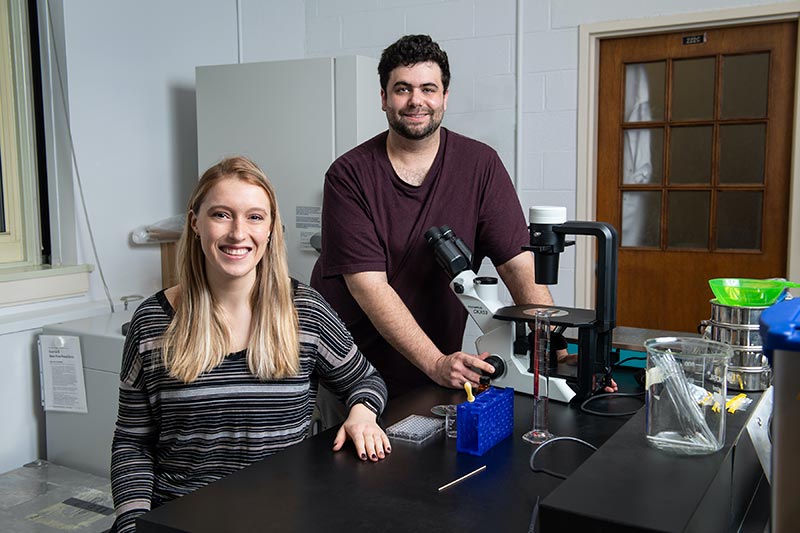UNB graduate students conducting research on climate change
Author: UNB Newsroom
Posted on Feb 4, 2020
Category: UNB Fredericton

Two graduate students from the faculty of science at the University of New Brunswick Fredericton were eager to spend a portion of last summer wearing winter jackets.
Both students spent their summer in the Arctic, where they conducted research on climate change and oceanography. PhD candidate Joshua Evans travelled through the North Water (NOW) polynya and Nares conducting field sampling for paleogenetic research on marine phytoplankton and sea-ice evolution over the last 4,000 years. This research was completed over six weeks onboard the CCGS Amundsen, an icebreaker and Arctic research vessel that supports a number of floating laboratories. Master of science student Kelsey Koerner participated in an expedition onboard the research vessel William Kennedy, where she performed surveys and collected samples in polynyas located around Southampton Island, in Hudson Bay. Her research focuses on long-term changes in sea-surface conditions in the NOW polynya.
Evans and Koerner are both currently working in the PAst Primary production and Environmental Reconstructions (PaPER) lab under the supervision of Dr. Audrey Limoges. The goal of their research is to develop a better understanding of climate-driven change in the physical and biological systems of the Arctic Ocean. By understanding these changes, Evans and Koerner hope to help scientists better predict how current climate warming trends will impact the future formation and productivity of the NOW polynya, which forms each year in northern Baffin Bay.
“Polynyas are described as regions of open water where you would otherwise expect to have sea-ice cover,” says Evans. “Open water conditions allow for more light to reach surface waters, which promotes a longer period for primary production.”
According to Evans and Koerner, a high level of productivity is critical to the ecosystem since it sustains a large and diverse food web, which provides resources to local communities and refuge for large marine mammals in northern Greenland and Ellesmere Island.
The two students use different approaches to reconstruct paleoenvironmental conditions in the region. Evans’ research focuses on marine diatoms, which are microalgae that dominate the phytoplankton communities in the NOW. By using sedimentary ancient DNA (sedaDNA), which are DNA molecules left behind by past organisms and preserved in sediment, he hopes to determine how changes in diatom diversity relate to corresponding changes in their primary productivity, and to quantify the sedaDNA of specific species for reconstructions of sea-ice concentration.
While Evans’ research uses sedaDNA, Koerner’s research involves the use of microfossil assemblages. She uses the marine microorganism dinoflagellates which produce cysts during times of unfavourable environmental conditions. Dinoflagellate cysts are sensitive to changes in the sea surface conditions. Therefore, they can act as witnesses of changes in sea-surface conditions over time.
What’s key about Evans’ and Koerner’s research is that they had a chance to collaborate with scientists from not only Canada, but all over the world. Crucially, the research expeditions also worked with local communities within their study regions. Working with these communities allowed research scientists to engage with the people who live in these regions and for each group to gain new insights and information from one another.
“The interactions with local communities were very valuable and essential to understand and identify the research needs for the local communities and ensure meaningful collaboration,” explains Koerner.
Now that both Evans and Koerner have returned from their research trips, samples will be prepared for analysis and subsequently used to reconstruct the paleoenvironmental conditions in Dr. Limoges’ lab at UNB.
Dr. Gary Saunders, dean of the faculty of science at UNB Fredericton, and Evans’ PhD co-supervisor, believes that this research is important for understanding changes in Arctic productivity in response to climate change.
“This productivity drives local ecosystems, which are foundational to the subsistence and cultural survival of Arctic Indigenous Peoples,” he says. “The students benefited from meaningful experiential opportunities and were given a chance to meet world-leading scientists in their fields. It was also significant for them to meet the local Indigenous Peoples in order to hear first-hand accounts of the changes they have faced and their concerns for the future.”
The research projects were funded by contributions from NSERC Discovery and Harrison McCain Foundation grants, as well as the Northern Scientific Training Program (NSTP). ArcticNet also contributed to support Evans’ fieldwork onboard the Amundsen.
What does this mean for the Maritimes and New Brunswick specifically? Evans and Koerner both agree that this type of research can provide beneficial insight into the potential impacts of climate change on our region.
“In a time where the Arctic is warming at twice the global average rate, it is important to understand how the system has responded to past changes,” says Koerner. “By looking back in time, we will be able to understand how the NOW has responded to past climate fluctuations.”
“This information can be used to better predict how the system may respond to changes in the future,” adds Evans. “The Arctic is often referred to as the “canary in the coal mine” and the changes that happen there will have an influence on the global climate system as a whole, including the Maritimes and New Brunswick.”
Media contact: Angie Deveau
Photo: Kelsey Koerner and Joshua Evans. Credit: Rob Blanchard/UNB.
